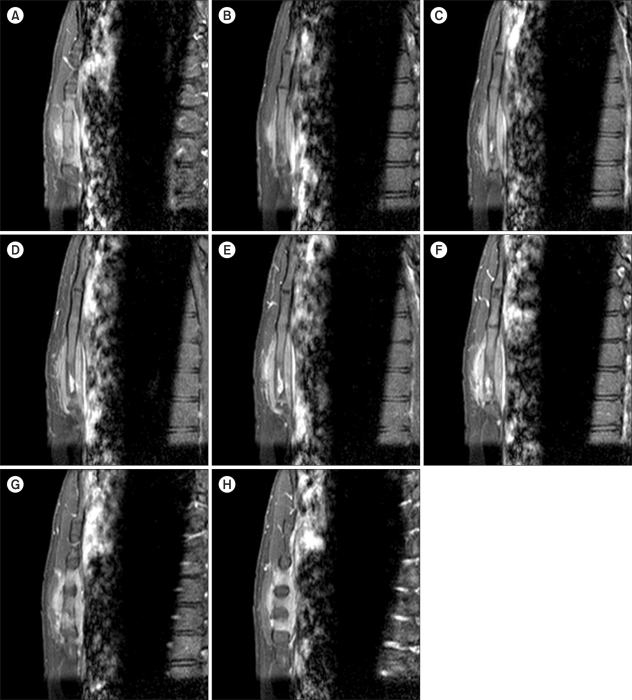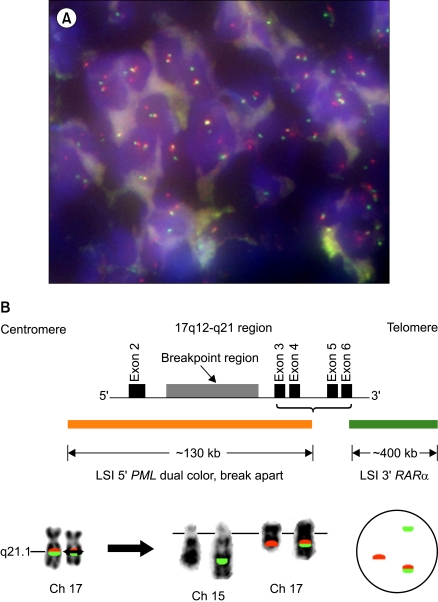A 19-year-old man who had a history of asthma and resultant steroid treatment presented with sternal pain, fever, and fatigue in December 2009. Physical examination revealed a solid sternal extramedullary mass with local erythema, and the patient reported persistent pain. Neither trauma nor infection was reported. Magnetic resonance imaging (MRI) scans showed edema, periosteal reaction, and irregular signals from the bone marrow (
Fig. 1). Antibiotic therapy was initiated because of the putative diagnosis of osteomyelitis. However, the pain persisted, thereby prompting reevaluation. The blood cell count was normal: hemoglobin, 15.9 g/dL; red blood cells, 5.5×10
12/L; white blood cells, 7.4×10
9/L (with neutrophils, 3.2×10
9/L; eosinophils, 0.4×10
9/L; lymphocytes, 2.9×10
9/L; and monocytes, 0.4×10
9/L); and platelets, 202×10
9/L. In March 2010, the patient underwent surgery. A lobulated tumor that was stuck to the sternum but did not infiltrate it was removed during surgery. Complementary biopsies of the sternum and the peri-sternal tissue were performed. Histopathological examination of the tissue revealed an infiltration by myeloid cells, of which some cells had a promyelocytic morphology and contained azurophilic granulations and Auer rods. The immunophenotypic study was limited to specific antigens, but most of the cells did not express CD34. Cytogenetic studies of the
PML/RARα fusion gene by using FISH (LSI probe) and
PML/RARα dual color probe (Dual fusion translocation probe, Vysis/Abbot) showed t(15;17) (q22;q21-22) (
Fig. 2). Diagnostic workup of the patients, including determination of the coagulation profile and assessment of the bone marrow aspirate, yielded normal results, and neither atypical promyelocytes nor blast cells was detected in the peripheral blood and bone marrow. In addition, negative results were obtained in cytogenetic and PCR analysis for
PML/RARα transcription in peripheral blood and bone marrow cells. Taken together, the results suggested a diagnosis of PS. The patient was treated in accordance with the French APL-2006 trial: a combination of all-
trans retinoic acid (ATRA) (45 mg/m
2/day for 30 days), idarubicin (12 mg/m
2/day for 3 days), and cytarabine (200 mg/m
2/day for 7 days) was administered. Further evaluation of the patient after induction therapy was not possible because of the specific morphological and molecular results at the time of diagnosis. However, the patient still received 2 additional courses of consolidation chemotherapy followed by local radiotherapy in the sternal region, and a 2-year maintenance therapy involving oral administration of 6-mercaptopurine and methotrexate was scheduled.
 | Fig. 1Magnetic resonance imaging of the sternum. Sagittal-weighted images (A to H) show injury to almost the entire sternum. The sternum shows an obvious abnormality at the distal end with a centro-osseous necrotic mass measuring 24 mm in transverse section, 7 mm in thickness, and 20 mm in height. The soft tissue swelling in the pre- and retro-sternal areas is significant with intense enhancement spanning nearly 50 mm. 
|
 | Fig. 2The reciprocal and balanced t(15;21), involving the PML gene on chromosome 15q22 and the RARα gene on chromosome 17q12.1, is a characteristic molecular feature of APL. In APL cells containing t(15;17), 1 orange (PML), 1 green (RARα), and 1 fusion (PML/RARα) signal pattern is observed (A). Two gene fusion products result from this translocation and encode the functional chimeric proteins: PML/RARα and RARα/PML. The LSI PML/RARα probe is a mixture of 2 FISH DNA probes. LSI PML is labeled in spectrum orange and LSI RARα is labeled in spectrum green (B). 
|






 PDF
PDF ePub
ePub Citation
Citation Print
Print



 XML Download
XML Download